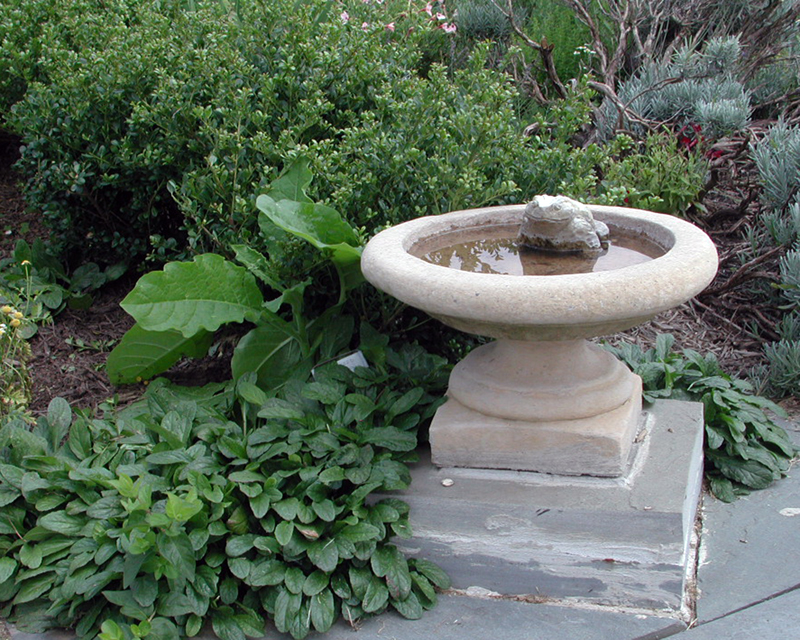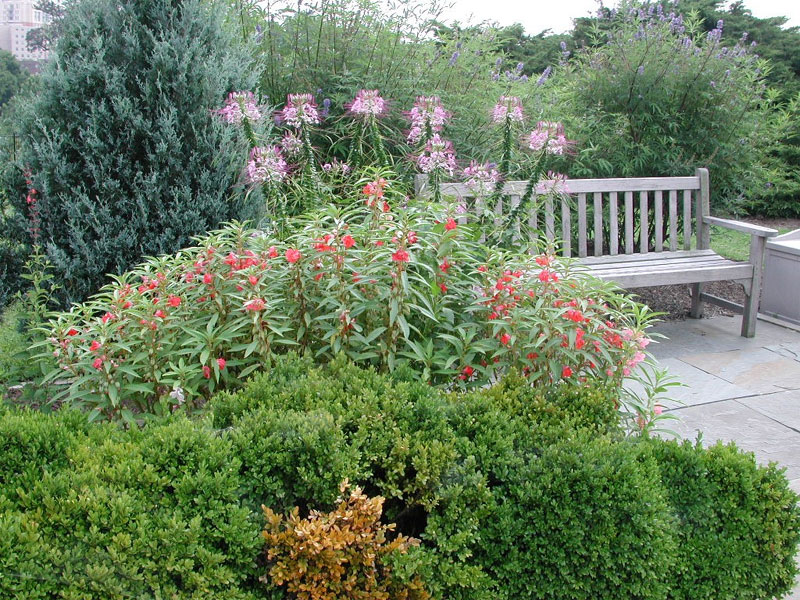There are approximately 75-100 kinds of herbs and flowers in the National Library of Medicine herb garden. Plants have a long and rich history of medicinal use and, even in the era of modern medicine, their medicinal properties are still sought after.
One of the classics of herbal medicine was written over 350 years ago, Culpeper's The Complete Herbal, published in London in 1649. This has proved to be an enduring book, going through 100 editions.
Nicholas Culpeper (1616-1654) was born into a landed gentry family and studied at Cambridge University, but abandoned his studies upon the death of his fiancee who was killed by lightening. He apprenticed with a London apothecary and set up practice among the poor, often charging no fee for his herbal remedies.
He favored British plants over the more exotic species and published his book in English rather than Latin, an unusual move, so that the common people (at least those who could read) could understand what he wrote.
A rather colorful figure with strong opinions (he received a chest wound from a musket shot fighting in a civil war), Culpeper died at age 38 from tuberculous which was probably compounded by his war wound and his intensive smoking.
Culpeper had infuriated the medical establishment during his lifetime. Apothecaries frequently “practiced” medicine, diagnosing illnesses and prescribing medication, but they charged less money than physicians. In many cases apothecaries were the only healer the poor could afford.
We include below descriptions of some herbs adapted from Culpeper's book. The listed plants are among the almost 100 in the NLM herb garden. A cautionary note: do not to try this at home! Culpeper was not a scientist his plant remedies are not necessarily proven therapies.
For a more complete listing of herbs and their medicine properties, see MedlinePlus' herbs and supplements section.
Herb List
Chamomile – Anthemis nobilis – Chamomile is said to take away weariness and pain/inflammation of the bowels. The oil from the flowers can be used against many pains and aches, including joint cramps. Chamomile is also helpful in healing migraines and regulating menstrual periods.
Cinquefoil – Potentilla reptans – Cinquefoil is used to reduce inflammation. It can also treat sore mouths and ulcers. The juice is known to aid jaundice. As well as helping hoarseness of the throat and cough, Cinquefoil can be applied to painful joints.
Columbine – Aquilegia vulgaris – Because columbine is slightly poisonous, its astringent properties are mainly exploited in lotions and used externally.
Feverfew – Chrysanthemum parthenium - Feverfew is known as an effective treatment for migraine headaches and fevers. It may also help ease diseases like arthritis.
Foxglove – Digitalis purpurea – A pure form of the plant is used to strengthen cardiac contractility and regulates heart rhythm.
Golden Rod – Solidago virgaurea – Golden rod can be used as a treatment for painful menstruation, arthritis and eczema. Externally, it can be applied to skin ulcers to stimulate healing.
Lady's Mantle – lchemilla vulgaris - This herb has been used to cure excessive menstruation. The root of lady's mantle has been recommended to stop bleeding.
Lavender – Lavandula angustifolia – Lavender prevents fainting and allays nausea. In oil form, it is often used in therapeutic baths to reduce stress. It can also lower blood pressure. A small amount makes a useful application on skin diseases like eczema and psoriasis.
Lovage – Levisticum officinale – Lovage is used as a digestive aid. It eases inward pains. This herb is also known to diminish redness of the eyes.
Pennyroyal – Mentha pulegium – Pennyroyal is said to ease headaches. It has been used as a remedy for colicky pains in the abdomen. It has also been known to ease the feverish symptoms that come with measles and whooping cough.
Poppy – Papaver rhoeas – The poppy is known to soothe coughs and induce sleep. The petals are helpful in treating asthma, bronchitis, whooping cough and angina.
Primrose – Primula vulgaris – Primrose, a sedative, induces rest and sleep by reducing tension. An infusion of the root taken in spoonful doses is effective in healing headaches. It has also been used for treating gout and rheumatism.
Rosemary - Rosmarinus officinalis – Rosemary has been used to treat headaches, epilepsy and poor circulation. It can also be used as a disinfectant in the form of mouth wash and also to treat fever. It is also reported to stop dandruff and improve memory.
Sage – Salvia officinalis – Sage is helpful for head pains, hoarseness and cough. It is one of the best known remedies for laryngitis, tonsillitis and sore throats. An infusion of the herb sweetened with honey is mildly laxative and stimulates menstrual flow.
Sorrel – Rumex acetosella or Rumex acetosa – The cooling leaves of sorrel are known to allay thirst and aid in fevers. These leaves also serve as a diuretic.
Vervain – Verbena officinalis – Vervain is known to be a good remedy for coughs and colds. It aids against the wheezing and shortness of breath that comes with fevers.
Wintergreen – Pyrola minor – Wintergreen is known for its cooling properties, flavoring everything from mouthwash to gum. Medicinally, it can be used topically on wounds and internally to aid ulcers in the kidney and bladder. The plant contains a natural antiseptic.
Woodruffe (Sweet) – Galium odoratum – Woodruff can be taken for its tranquilizing effects to treat insomnia. Used as an infusion, it can strengthen the stomach and removes obstructions from the colon.
Yarrow – Achillea millefolium – Yarrow is used topically for wounds, cuts, and abrasions. An infusion of yarrow is known to speed recovery from sever bruising. Yarrow flowers are used for various allergic mucus problems, including hay fever.
Source: Potterton, David., ed. Culpepper's Color Herbal. New York: Sterling, 1983.
Last Reviewed: October 24, 2022




